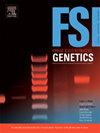Independent evaluation of an 11-CpG panel for age estimation in blood
IF 3.1
2区 医学
Q2 GENETICS & HEREDITY
引用次数: 0
Abstract
DNA methylation patterns have emerged as reliable markers for age estimation, offering potential applications in forensic investigations, namely, in cases where there is no information about a possible suspect, in the identification of victims of mass disasters, or in immigration cases when assessing the age of individuals seeking asylum. This study aimed to evaluate the 11-CpG panel proposed by Aliferi et al. (2022) for age estimation. During the implementation phase, the ELOVL2 amplicon from the original work was replaced with a shorter fragment, and the two PCR multiplexes were optimized by changing the amplicons and primer conditions of each multiplex. The technical performance of the optimised assay was assessed using artificially methylated DNA standards. Robust quantification of the methylation levels at the 11 CpG sites was observed. Sensitivity tests demonstrated that DNA inputs down to 10 ng could produce reliable methylation quantification. Using the optimised panel, 148 Danish blood samples (18 – 68 years of age) were typed for their methylation status at the 11 CpG sites. Results showed that the DNA methylation at the 11 CpG loci was significantly correlated with age (0.68 ≤ r ≤ 0.88) in the Danish sample set, confirming the potential of the 11 CpGs in age prediction. A Danish age prediction model was constructed using 108 of the Danish blood samples and a support vector machine with polynomial function (SVMp). The performances of the new model and the original model based on UK individuals were compared using the remaining 40 Danish blood samples. Comparing the published model to the one developed in this study gave similar results with mean absolute errors (MAE) of 3.28 and 3.35, respectively. However, the original model showed a bias in the age predictions, underestimating the age by an average of 1.53 years in the Danish samples. This bias towards underestimation was not observed in the newly developed age prediction model based on Danish individuals. In summary, this assay provides a reasonably accurate age estimation of a single-source donor, if the sample material is blood and more than 10 ng of nuclear DNA can be extracted from the sample.
独立评估血液中11-CpG面板的年龄估计。
DNA甲基化模式已成为估计年龄的可靠标记,在法医调查中,即在没有关于可能嫌疑人的信息的情况下,在确定大规模灾害的受害者时,或在移民案件中评估寻求庇护者的年龄时,提供了潜在的应用。本研究旨在评估Aliferi等人(2022)提出的用于年龄估计的11-CpG面板。在实施阶段,将原始作品中的ELOVL2扩增子替换为更短的片段,并通过改变扩增子和引物条件来优化两个PCR多片段。使用人工甲基化DNA标准评估优化分析的技术性能。观察到11个CpG位点的甲基化水平的稳健量化。灵敏度测试表明,DNA输入低至10 ng可以产生可靠的甲基化定量。使用优化的面板,对148份丹麦血液样本(18 - 68岁)在11个CpG位点的甲基化状态进行分型。结果显示,在丹麦样本集中,11个CpG位点的DNA甲基化与年龄显著相关(0.68 ≤r ≤ 0.88),证实了11个CpG位点在年龄预测中的潜力。利用108份丹麦人血液样本,利用多项式函数支持向量机(SVMp)构建丹麦人年龄预测模型。新模型和基于英国个体的原始模型的性能使用剩余的40个丹麦血液样本进行了比较。将已发表的模型与本研究开发的模型进行比较,结果相似,平均绝对误差(MAE)分别为3.28和3.35。然而,最初的模型在年龄预测中显示出偏差,丹麦样本的年龄平均低估了1.53岁。在基于丹麦个体的新开发的年龄预测模型中没有观察到这种对低估的偏见。总之,如果样品材料是血液,并且可以从样品中提取10 ng以上的核DNA,则该检测方法可以相当准确地估计单一来源供体的年龄。
本文章由计算机程序翻译,如有差异,请以英文原文为准。
求助全文
约1分钟内获得全文
求助全文
来源期刊
CiteScore
7.50
自引率
32.30%
发文量
132
审稿时长
11.3 weeks
期刊介绍:
Forensic Science International: Genetics is the premier journal in the field of Forensic Genetics. This branch of Forensic Science can be defined as the application of genetics to human and non-human material (in the sense of a science with the purpose of studying inherited characteristics for the analysis of inter- and intra-specific variations in populations) for the resolution of legal conflicts.
The scope of the journal includes:
Forensic applications of human polymorphism.
Testing of paternity and other family relationships, immigration cases, typing of biological stains and tissues from criminal casework, identification of human remains by DNA testing methodologies.
Description of human polymorphisms of forensic interest, with special interest in DNA polymorphisms.
Autosomal DNA polymorphisms, mini- and microsatellites (or short tandem repeats, STRs), single nucleotide polymorphisms (SNPs), X and Y chromosome polymorphisms, mtDNA polymorphisms, and any other type of DNA variation with potential forensic applications.
Non-human DNA polymorphisms for crime scene investigation.
Population genetics of human polymorphisms of forensic interest.
Population data, especially from DNA polymorphisms of interest for the solution of forensic problems.
DNA typing methodologies and strategies.
Biostatistical methods in forensic genetics.
Evaluation of DNA evidence in forensic problems (such as paternity or immigration cases, criminal casework, identification), classical and new statistical approaches.
Standards in forensic genetics.
Recommendations of regulatory bodies concerning methods, markers, interpretation or strategies or proposals for procedural or technical standards.
Quality control.
Quality control and quality assurance strategies, proficiency testing for DNA typing methodologies.
Criminal DNA databases.
Technical, legal and statistical issues.
General ethical and legal issues related to forensic genetics.

 求助内容:
求助内容: 应助结果提醒方式:
应助结果提醒方式:


